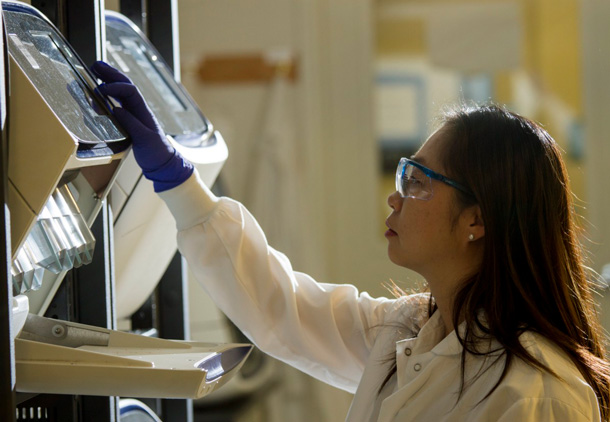
Developing Biomarkers for Immunotherapy: A Conversation with Drs. Magdalena Thurin and Helen Chen
July 27, 2018, by NCI Staff
NCI is supporting a new network of research centers and a data center created to develop biomarkers for immunotherapy. The network consists of four Cancer Immune Monitoring and Analysis Centers (CIMACs) and a data storage center, the Cancer Immunologic Data Commons (CIDC).
In this interview, Magdalena Thurin, Ph.D., of the Cancer Diagnosis Program and Helen Chen, M.D., of the Cancer Therapy Evaluation Program, both in NCI’s Division of Cancer Treatment and Diagnosis, discuss the network and its goals.
What is the goal of the research network?
Dr. Thurin: The long-term goal is to identify molecular signatures or biomarkers that, in the future, doctors can use to identify patients with cancer who are likely to respond to immunotherapy.
Dr. Chen: Biomarkers identified as a result of this project could also be used to help investigate mechanisms of resistance to immunotherapy, which may guide the development of combination therapies that may overcome this resistance. In addition, biomarkers could be identified that help to monitor patients’ responses to treatment.
How will the new network of laboratory centers and the data center achieve this goal?
Dr. Thurin: The four centers, or CIMACs, will use state-of-the-art technologies to perform a range of molecular and cell-based testing on biospecimens—such as blood and tumor samples—from patients enrolled in early-phase immunotherapy clinical trials—phase 1 and phase 2—that are funded by NCI. These test results and clinical information about patients will be stored in the CIDC, which researchers can then use in follow-up studies to identify potential biomarkers.
Dr. Chen: The four CIMACs will use standardized assays for analyzing biospecimens collected from these immunotherapy clinical trials. That will ensure that there is a uniformity in their work and the results they produce, and it will give us more statistical power and provide greater confidence in any potential biomarkers that are identified.
Can you explain how the CIMACs are set up?
Dr. Chen: Each of the four CIMACs—Dana-Farber Cancer Institute, Stanford University, MD Anderson Cancer Center, and Icahn School of Medicine at Mount Sinai—has a multidisciplinary team with expertise in immunology, clinical investigation, pathology, bioassays, and bioinformatics.
These teams will work closely with the clinical investigators who are leading the early-stage immunotherapy trials to design their biomarker studies, apply different assays for identifying potential biomarkers, and analyze the results.
Why are biomarkers of response to immunotherapy needed?
Dr. Chen: Currently, a minority of patients with cancer benefit from immunotherapies. But we don’t know why only some patients respond to immunotherapy, and we cannot reliably predict which patients will benefit from the therapy. Validated biomarkers could help guide treatment decisions for patients and doctors who are considering immunotherapy.
Dr. Thurin: In addition, to improve the effectiveness of immunotherapies, we need to develop a better understanding of how the immune system interacts with tumors, which can help us develop tools for selecting the appropriate patients for a specific immunotherapy or combination therapy.
Do any biomarkers exist that can help guide treatment decisions about immunotherapy?
Dr. Chen: In recent years, several potential biomarkers have emerged, such as levels of a protein called PD-L1 expressed on tumor cells and immune cells in the tumor microenvironment. Another biomarker is tumor mutational burden, which is an assessment of the number of genetic mutations in a tumor. But we still need biomarkers that are more precise.
What is the CIDC’s role?
Dr. Thurin: The CIDC is hosted at Dana-Farber Cancer Institute and has multiple functions. But its primary role is to collect the biomarker data generated at the four CIMACs and to provide a platform for integrating patients’ clinical data—such as age, prior treatments, response to treatment, side effects—with data on the biospecimens. Having all of this information in the CIDC will help other researchers explore the data for biomarkers.
The CIDC will also provide some of the informatics tools for the analyses of the data. In the future, the CIDC is expected to serve the cancer research community in a manner similar to NCI’s Genomic Data Commons.






















.png)












No hay comentarios:
Publicar un comentario